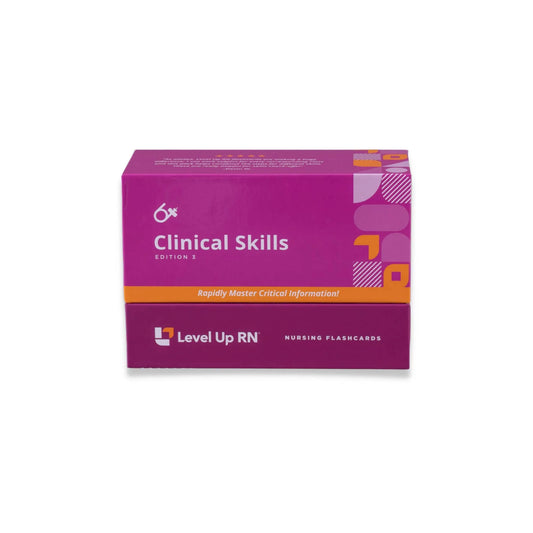Clinical Skills - Applying Electrodes for a 12 lead EKG
How to apply electrodes for a 12 lead EKG.
Full Transcript: Clinical Skills - Applying Electrodes for a 12 lead EKG
Full Transcript: Clinical Skills - Applying Electrodes for a 12 lead EKG
Hi, I'm Ellis with Level Up RN. In this video, I'll be demonstrating how to place electrodes for a 12-lead EKG. I'll be using the rules that we've got on our clinical nursing skills deck. So if you have this deck, grab this card, and you can follow along with me. If you don't have the deck and you're interested in getting one, you can pop over to leveluprn.com.
Just a few notes of clarification before we begin. I did say that you can use the nipple line as a guide for your placement, but never rely wholly on it. You should be feeling for the intercostal spaces. For example, V3 is in fact between V2 and 4, of course, but it needs to be on an intercostal space, not just randomly in between those two leads. Also, when we're placing our limb electrodes, they should be at the same level, I suppose. So I should not place electrodes on the arms at the wrist and the electrodes for the legs at the hips, right? If I'm going to use the wrist placement for some reason, I should use the ankle placement for some reason. And again, I don't want to put them on the actual bone itself, but I do want them to be on the same plane, if that makes sense.
Place the electrodes onto my patient's chest. This is pretty straightforward. So first, I'm going to ask him if I can expose his chest. So I'm going to say, "If you don't mind, I'm going to pull your gown down temporarily." We're going to need to see at least to about there. We'll also need to pull up his gown a bit to put our lower leads. So I usually just pull it up from the bottom like this. So your leads are all labeled V1 through V6. So I need to rifle through them and find V1. V1 is going to be placed on the right. And when I say left and right, I mean his left and right. So don't forget I'm working with the patient's left and right. So I'm going to do the right fourth intercostal space onto the right of the sternum. For V2, it'll be the exact same but on the left of the sternum. I'm going to skip to V4 because V4 is the fifth intercostal space mid clavicular line on that left side. So V4 would be about here. And I'll go back to that V3, which is literally just between those two. So I'll go ahead and tab those ones. This is V3. Here's V2. Honestly, 60% of this skill is just untangling lines. V4. And kind of like how I skipped before, I'm going to skip again. Instead of doing V5, I like to go ahead and place V6 because it's mid axillary, so right in the middle of the armpit. So that's V6. And V5 is in between V4 and V6.
The last part is to get my right and left arm and leg on. So I'll get my right arm and leg out because remember I'm doing the patient's right arm and leg. So I'll place a tab for the arm and the leg. And the leg doesn't technically have to be on the leg, but it does need to be lower than the umbilicus. So you may see people do it on the lower portion of the abdomen. So we'll do right arm and the right leg and the left arm and the left leg. Now the arm and leg electrodes are always the same color. And we like to say the phrase that it is smoke over fire, so I've got black over red, and air over ground, or white over green. And so even if they weren't labeled, which I think almost all facilities and companies have labeled them now, right? I have a little LA LL for left arm and left leg. It's smoke over fire and air over ground.
Now if we count the electrodes here, you'll notice I've only put on 10 electrodes, but we call this a 12-lead EKG. And that's a really common misconception of it meaning I have 12 leads. I don't actually have 12 electrodes or leads. I have 12 images or angles that are used to examine the heart when I use this machine, But I actually only have 10 physical electrodes. Once all my electrodes are placed, all I need to do is make sure that my device is turned on, and I ask my patient, "All right, if you could just breathe calmly and stay still for about 10 seconds." I want him to stay as still as possible because if he moves around and stuff, then the picture I'm going to get is going to have artifact on it which is not actually going to be what's happening with his heart. So I'm going to have him stay still for about 10 seconds, and I'll hit print. And my machine will either print it, or it might electronically transfer it to his medical record. And then I simply remove my electrodes and make sure I clean the paste off.


